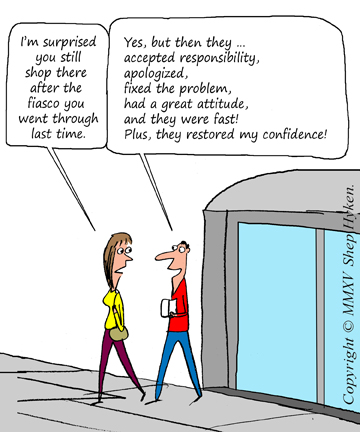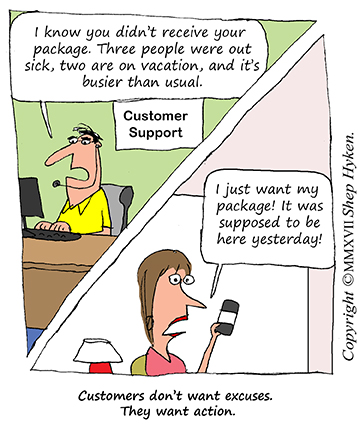
Complaint Management: The Path to Customer Satisfaction
Last update: 2 April 2024 at 01:41 pm
Companies have always had to deal with criticism and complaints from their customers. But the age of the internet, and especially social media platforms such as Facebook and Instagram, have opened up a whole new dimension of complaint management.
Today, a customer can get in touch with brands directly and publish testimonials and assessments of a product or service online. These experiences, in turn, are often the basis for the purchase decision of potential new customers who inform themselves about your products in advance on the Internet.
That’s why it’s important to have a strategy for complaint management and to train your employees to deal with criticism from customers. In this article, we explain what exactly complaint management is, why it is so important, and how your company can best respond to customer criticism and problems.
What Is Complaint Management?
Complaint management is the strategic handling of and response to customer complaints.
The aim is to prevent customers who complain from leaving the company and to prevent their negative reports from deterring potential new customers from making a purchase.
In short, this means taking customer complaints seriously and actively addressing their wishes and suggestions.
Why Is Complaint Management So Important?
As mentioned above, complaints that are not handled well can lead to even a loyal customer leaving and preferring other competitors in the future. This should be prevented with a mature complaint management system.
In addition, frequent and, above all, bold complaints can also lead to other customers becoming insecure in their trust in your company and therefore also refraining from buying from you in the future.
This not only results in a loss of sales, but also, in the worst case, a permanent damage to your image. But these are by no means the only reasons why complaint management should play a role in every company, because good handling of customer complaints can:
- Improve your customer relations in the long term
- Give you valuable insights into the wishes and needs of your customers
- Lead to customers recommending your company to others in a more positive way
- Have a lasting positive influence on your image and the reputation of your company
- Reveal potential gaps or deficiencies within your company
- Help to solve internal problems and optimize processes.
Is Every Critique Also a Complaint?
Before we delve deeper into concrete complaint management measures, it is important to clearly define what exactly constitutes a complaint. In fact, the internal definition can make a big difference in how criticism is addressed.
Complaint management is often equated with reclamation management. However, a complaint and a reclamation are by no means always the same thing.
- A reclamation refers to the return of a product because it has defects. This could be an open seam in a garment, for example, or an incompletely delivered product set. In most countries, the customer has the right to complain about the product and only complains to you because of a clear defect.
- Complaints, on the other hand, are often not just focused on one product, but span an entire process. The customer wants to vent his displeasure about his experience with your company.
Accordingly, not every reclamation is also a complaint – and you do not have to use the full leverage of your complaint management to respond to a reclamation. Rather, in this case, you should question your internal processes and make an active effort to remedy the defects in your goods.
What Is the Best Way to Handle Complaints?
It is not always easy to deal with complaints from customers – especially when they are emotionally charged and perhaps not 100% rational. But it is precisely for these cases that it is important to set up a functioning complaints management system and train your employees accordingly.

As a rule, this concerns employees in customer service, also known as customer relationship management. The goals of complaint management should be clearly communicated to employees in advance.
Of course, marketing, sales and quality assurance also play a role here, but good complaint management should always consider customer satisfaction as the top priority.
Accordingly, customer feedback should not be viewed primarily from the company’s perspective, but rather from the customer’s point of view: What went wrong? What could have been done better? And above all: What can now actively help to defuse the situation and satisfy the customers?
These processes should be laid down in internal guidelines and manuals and actively communicated to employees in training courses and seminars.
Good to know: There is an internationally recognized complaint management standard, DIN ISO 10002, which clarifies key terms and helps companies establish good complaint management.
Direct Complaint Management
Good complaint management is generally divided into two areas: Direct and indirect complaint management.
Direct, or active, complaint management refers to all measures that are directly visible and tangible for customers.
This includes, above all, the provision of contact options via a service hotline or an e-mail address from a service employee, for example, as well as the subsequent communication and exchange with customers. Active complaint management is divided into four different levels: stimulation, acceptance, processing and reaction.
Stimulation
The first stage is when your customers contact your company to make a complaint. This is done via the communication channels you provide, for example, by e-mail, via a contact form, a telephone number, or a live chat on your website.
It is important that customers find the contact options directly and without any problems and do not have to click through numerous sub-pages on your site first. In the worst case, this can increase frustration and give customers the impression that your company does not want to deal with complaints.
Acceptance
After you have defined the contact options, you should take care of the internal process handling. It is important that all employees have the same information and know who is responsible for further processing of the complaint and the resulting tasks. A clear distribution of tasks is the key to success here to ensure that customers and their concerns end up with the right contact person.
Processing
The central task for customer complaints is to process them appropriately. This means that you must review the customer’s concerns and find a solution to the problem. If this cannot be done immediately when contacting the customer, you should define a time frame for further processing. This can help manage customer expectations – and providing information about internal processes also demonstrates a level of transparency.
Reaction

Finally, there should be an appropriate response to the customer’s complaint. This should be predefined based on internal guidelines so that your employees do not have to find an individual solution each time, but can refer to predefined processes.
For example, if a customer complains about a late delivery, you could offer them a free delivery on their next order. When it comes to complaint management, you could consider exchanging the defective product for a new one. And if the complaint is about general dissatisfaction with an employee, an apology may be the appropriate response.
Indirect Complaint Management
Good complaint management should also stimulate an indirect reaction behind the scenes to balance out active handling of complaints.
Indirect complaint management refers to the internal processes that are triggered by a customer complaint in a company. These also consist of four different stages: evaluation, controlling, reporting and information utilization.
Evaluation
As a first step, you should collect all complaints from your customers and evaluate them. Is it possible to bundle certain complaints thematically? Or can you already identify specific deficiencies in your company on the basis of the customer information?
Controlling
The second step involves controlling customer complaints. This is subdivided into three further sub-areas:
- Evidence controlling
- Task controlling
- Cost-benefit controlling
Evidence controlling checks whether the customer’s complaint has reached the predefined point.
Task controlling checks whether the customer’s concern has been responded to appropriately.
And cost-benefit controlling examines how the complaint management process affects the economic situation and the general success of the company.
Reporting
The findings and information from complaint management controlling are now summarized in a report in order to present them appropriately to the relevant decision-makers from marketing, sales or other corporate divisions and to define goals for improving customer loyalty.
Information Utilization
Finally, the last step is to draw conclusions from the findings of the complaint management process and to record tips and goals for improving customer relations for departments such as Marketing, Sales and Customer Relations.
In addition, the information gained should help to permanently improve the quality of the products offered and also the internal processes.
Conclusion: The Customer is King
This saying has been around for a long time, but is not implemented in the same way everywhere. Customer loyalty and customer satisfaction should be part of the tasks and, above all, the goals of every company and should be actively supported with the help of an appropriate complaint management system.
An agency for customer acquisition can help you with the conception of your complaint management and the creation of a corresponding guideline.







